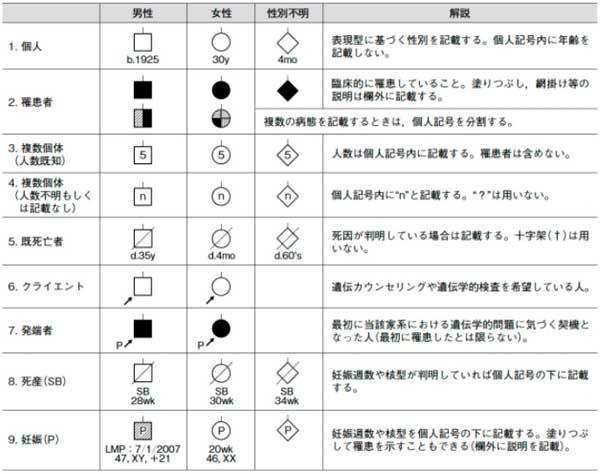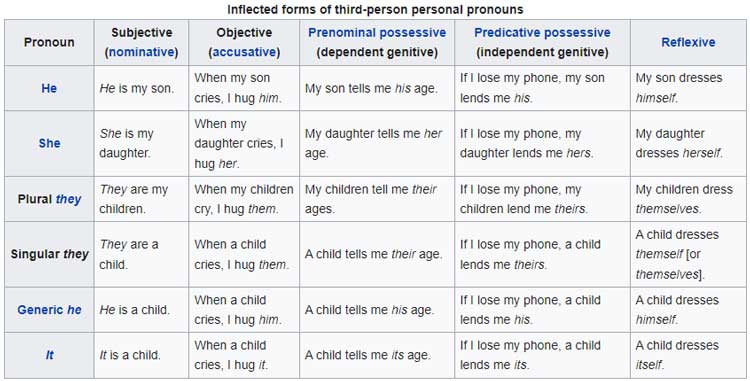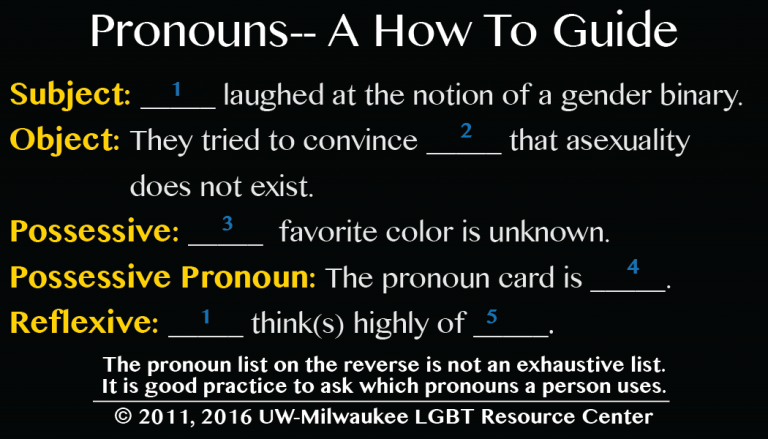
先日、”彼ら” を意味する “they/their/them/theirs” が、単数の人を指すときの代名詞として使える事を知りました。
普段から使っている人達には常識かもしれませんが、私的には目からウロコだったので、こちらでシェアしたいと思います。
性別を隠したいときに使う “they”
私がこの用法を教えてもらったのは、とあるケースレポートの原稿を書いていたときのこと。
稀な遺伝子変異で独特の表現型を示す家系について、その兄弟姉妹の遺伝子/生化/病理学的解析を行っていました。
ひとしきり原稿を書き終えた所で、共著の一人から提案されました。
「この家系は稀すぎるから、あまり情報が多いと個人が特定されてしまうかもしれない。
年齢を ~75 yo みたいに5年単位でぼかして、性別も隠した方が良いのでは?この遺伝形式は性別関係ないし。」
そこで私は提案された通りに年齢をぼかし、性別の情報も削除しました。
性別を消す時、家系図では、□(男性)/○(女性)ではなく、◇(性別不明)で表します。

で、問題は記述の方。
症例1は76歳の男性で、彼は○○歳の時にXXの症状で病院を受診し……
Case 1 is a ○○ year-old man. He came to our hospital at…
のように記載していた所を、
症例1はだいたい75歳くらいで、彼/彼女は○○歳の時にXXの症状で病院を受診し……
Case 1 is ~75 yo. He or she (He/She) came to our hospital at…
のように、He or she、もしくは He/She で書いてみたものの、無駄に言葉が長くて
「もっと適切な表現方法はあるかな?」
と共著者に相談してみました。
すると返ってきた答えが、
「”They” を使うと良いよ。”They” は gender-neutral だから。」
というもの。
gender-neutral な代名詞 “they”
私は、
「え、they って、複数形の代名詞じゃないの?彼/彼女みたいな単数形に使えるの?」
と不思議に思いましたが、我らのGoogle先生に尋ねると、この用法がたくさん出てきました。
例えば下記ページによると、
A gender neutral or gender inclusive pronoun is a pronoun which does not associate a gender with the individual who is being discussed. Some languages, such as English, do not have a gender neutral or third gender pronoun available, and this has been criticized, since in many instances, writers, speakers, etc. use “he/his” when referring to a generic individual in the third person. Also, the dichotomy of “he and she” in English does not leave room for other gender identities, which is a source of frustration to the transgender and gender queer communities.
英語には元々 gender-neutral な代名詞がなかったことが以前から問題になっており、一時期は “one” という単語が “he or she” などの代わりに使われた事もあったとか。
でも “one” だとちょっと侮辱的な印象もあるのであまり定着しなかったようです。
単数形の “they” は、古くは14世紀あたりから出現していて、18世紀あたりでは “文法的におかしい” と批判されたこともあったようですが、20世紀にはほとんどの文法書が単数形の “they” の使用を認め、1970年代くらいから、本格的に “they” が gender-neutral な代名詞として使用されるようになったようです。
じゃあ、”He is” のような使い方を単数形の “they” で使う場合はどうすればいいのかというと、正解は “They are”。
They are a child.
A child tells me their age.
の様な感じで使います。

“They are a child” とかかなり違和感がありますが、慣れていくしかないですね。
この “they”、今回のように症例の性別をぼかしたい場合にも有効ですが、日常では LGBTQ+ の人達を示す場合によく使われているそう。
確かに、性同一性障害の人達は “彼” や “彼女” と自分の生物学的性別で呼ばれたくない人も多いと思うので、このような代名詞は必要だと思います。
これからも使い方に気をつけながら多用していきたいです。
References
A gender neutral or gender inclusive pronoun is a pronoun which does not associate a gender with the individual who is being discussed. Some languages, such as English, do not have a gender neutral or third gender pronoun available, and this has been criticized, since in many instances, writers, speakers, etc. use “he/his” when referring to a generic individual in the third person. Also, the dichotomy of “he and she” in English does not leave room for other gender identities, which is a source of frustration to the transgender and gender queer communities.
Singular they, along with its inflected or derivative forms, them, their, theirs and themselves (or themself), is an epicene (gender-neutral) third-person pronoun. It typically occurs with an unspecified antecedent, in sentences such as: "Somebody left their umbrella in the office. Could you please let them know where they can get it?"[1] "The patient should be told at the outset how much they will be required to pay."[2] "But a journalist should not be forced to reveal their sources."[2]
Ⅰ. 総論 総論2.家族歴聴取と家系図記載法 1家系図作成の意義1)2)3) 近年,HBOCに適した治療薬や手術方法,サーベイランスの選択が可能となっている。そのため,乳癌や卵巣癌の患者のうちHBOC

